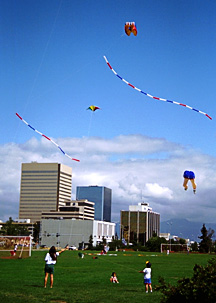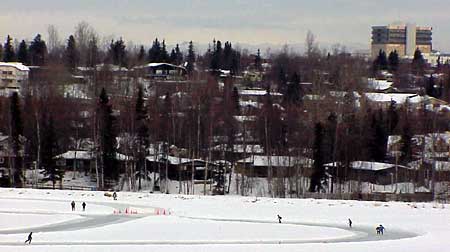|
A statue of the 18th century explorer
Captain Cook looks across Cook Inlet
|
|
||||||||||||||||||||||||||||||||||||||||||||||||||||||||||||||||||||||||||||||||||||||||||
Don't missThe Alaska Public Lands Information Center, 605 W. Fourth Ave., has information on Alaska's state and national parks and can provide assistance with maps and park passes. The Log Cabin Visitor Information Center, also on Fourth Avenue, is a good place to pick up brochures about things to see and places to stay. The log cabin with its sod roof is picturesque, and there's often outdoor entertainment in the adjacent Old Town Square. TransportationSeveral major airlines fly nonstop to Anchorage International Airport from cities including Seattle, Salt Lake City and Minneapolis. It can also be reached from Japan and the Russian Far East. Anchorage can also be reached by highway from the Lower 48 (it's a very long drive). The Alaska Railroad has connections from Anchorage to Seward, Denali National Park and Fairbanks. The Good Friday EarthquakeThe earthquake of March 27, 1964, was the most powerful ever recorded in North America. It registered 9.2 on the Richter scale. In Anchorage, a major fissure opened on Fourth Avenue and many buildings in the Turnagain area (where Earthquake Park now commemorates the event) were destroyed. 131 people were killed in the earthquake and in the tsunami waves it generated. Girdwood, Portage, Seward and Valdez all suffered severe damage. Deaths were recorded as far away as Oregon. The most visible effect of the earthquake today is the stands of dead trees that can be seen along the Turnagain Arm of Cook Inlet and in other areas along the coast. The trees were killed when ground movements during the quake flooded their root systems with salt water. |

 Alaska's
largest city has a complex personality. With a population of
about 280,000, it has all the amenities -- shopping malls, two
universities, half a dozen TV stations, major chain stores --
of a city of similar size in the Lower 48. But it also sits
on the edge of the wilderness. A salmon fishing derby is held
each summer at Ship Creek, just down the hill from downtown
Anchorage. Moose are a traffic hazard. Grizzly bears occasionally
get into the garbage of residents in the city's Hillside suburb.
Alaska's
largest city has a complex personality. With a population of
about 280,000, it has all the amenities -- shopping malls, two
universities, half a dozen TV stations, major chain stores --
of a city of similar size in the Lower 48. But it also sits
on the edge of the wilderness. A salmon fishing derby is held
each summer at Ship Creek, just down the hill from downtown
Anchorage. Moose are a traffic hazard. Grizzly bears occasionally
get into the garbage of residents in the city's Hillside suburb. The
Delaney Park Strip, just south of downtown Anchorage,
was once an air strip. Now it includes ball fields, tennis courts,
a garden, an old train engine for kids to climb over, and fields
that lend themselves to such activities as soccer and kite flying
(as in the photo above right). During the summer season ball
games can be watched late into the evening.
The
Delaney Park Strip, just south of downtown Anchorage,
was once an air strip. Now it includes ball fields, tennis courts,
a garden, an old train engine for kids to climb over, and fields
that lend themselves to such activities as soccer and kite flying
(as in the photo above right). During the summer season ball
games can be watched late into the evening.